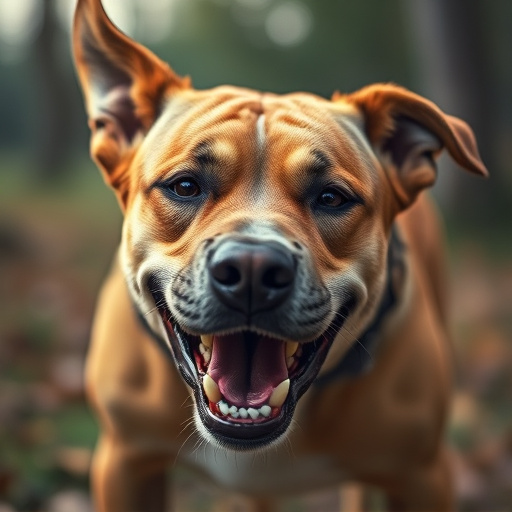Dog pepper spray offers a powerful defense against threats, using capsaicin to temporarily incapacitate attackers. Effective deployment requires understanding the Safe Spraying Distance for Dogs, typically 8-20 feet (2.4-6 meters), depending on spray type and environmental conditions. Selection should consider concentration, target size, nozzle type, and testing. Proper application techniques aim for face and eyes at a safe distance, with local regulations and handler training mandatory to prevent injuries and legal issues.
Dog pepper spray defense is a controversial yet potentially life-saving tool for pet owners facing aggressive canine encounters. Understanding how to effectively deploy this tactic involves grasping the principles of safe spraying distance, selecting appropriate products, and mastering application techniques. This comprehensive guide explores these key areas, emphasizing responsible use while equipping readers with crucial knowledge about dog pepper spray defense, especially in mitigating risks at safe spraying distances for dogs.
- Understanding Dog Pepper Spray Defense
- Factors Affecting Safe Spraying Distance
- Choosing the Right Pepper Spray for Dogs
- Effective Application Techniques for Canines
- Legal Considerations and Responsible Use
Understanding Dog Pepper Spray Defense
Dog pepper spray defense is a controversial yet powerful tool designed to protect both pets and their owners from potential threats. Understanding how it works and its safe spraying distance for dogs is paramount before considering its use. The spray is formulated with capsaicin, the same compound that gives chili peppers their heat, which can incapacitate an attacker temporarily.
When deployed correctly, dog pepper spray creates a safe zone by causing irritant symptoms like tearing, coughing, and difficulty breathing in the target area. The recommended safe spraying distance for dogs is typically around 10-15 feet (3-4.5 meters), ensuring minimal exposure while providing enough time to escape or de-escalate a situation. It’s crucial to follow manufacturer guidelines and local regulations regarding its use, as improper handling can have unintended consequences for both the user and bystanders.
Factors Affecting Safe Spraying Distance
The safe spraying distance for dog pepper spray is a crucial consideration, as it directly impacts effectiveness and safety. Several factors influence this critical aspect. First, the type of pepper spray used plays a significant role; different formulations have varying spray patterns and concentrations. For instance, specialized dog sprays often have a tighter spray radius, ensuring direct impact on the target animal’s eyes and nose.
Second, the distance at which the spray is deployed matters greatly. Closer proximity allows for more precise application, minimizing collateral damage and ensuring the pepper spray effectively disrupts an attacker’s behavior. However, the recommended safe spraying distance can vary based on environmental conditions, such as wind speed and direction, which can impact the spray’s reach and accuracy.
Choosing the Right Pepper Spray for Dogs
When selecting a dog pepper spray, understanding the safe spraying distance is paramount. This varies based on factors like the spray’s concentration and the size of the target animal. Generally, for dogs, a safe distance of 8 to 10 feet (2.4 to 3 meters) is recommended. Sprays designed for dogs often have lower capsaicin concentrations than those meant for humans, ensuring minimal harm while effectively deterring aggressors.
Choosing a spray with a stream or pulsating nozzle can help control the direction and range of the spray. Testing the spray in a controlled environment before facing an actual situation is advisable to ensure comfort with its application and understand the effective range. Always follow manufacturer guidelines regarding safety and usage, including storing it out of reach of children and pets.
Effective Application Techniques for Canines
When using dog pepper spray, understanding effective application techniques is key to ensuring its safety and success. The primary goal is to target specific areas that can quickly overwhelm an aggressor’s senses while minimizing impact on bystanders or the canine itself. For best results, maintain a safe spraying distance for dogs—typically around 15-20 feet (4.5-6 meters)—to avoid unnecessary distress to your pet or others nearby.
Hold the spray canister firmly and aim for the face and eyes of the attacking dog. This includes areas like the bridge of the nose, cheeks, and inside the nostrils. A quick burst of 1-2 seconds is usually sufficient to disrupt the attacker without causing prolonged harm. Always check local laws regarding pepper spray use, as regulations vary significantly from place to place.
Legal Considerations and Responsible Use
When considering dog pepper spray defense, it’s crucial to understand the legal implications and principles of responsible use. The safe spraying distance for dogs is a critical factor; excessive force or improper application can lead to severe consequences, including injuries and potential legal repercussions. Each jurisdiction has its own set of rules regarding the use of pepper spray on animals, with many requiring specific training and certifications for handlers.
Responsible use involves adhering to manufacturer guidelines, ensuring proper handling, and only deploying the spray when necessary to deter or control an aggressive dog. It’s essential to be aware of local laws and regulations to avoid criminal charges or civil lawsuits. Additionally, regular maintenance and storage of pepper spray canisters are vital to guarantee their effectiveness and safety in emergency situations.
Dog pepper spray can be a powerful tool for self-defense when used correctly. By understanding the safe spraying distance, selecting the appropriate pepper spray formula, and mastering application techniques, dog owners can effectively deter potential threats. However, it’s crucial to remember that responsible use and adherence to legal guidelines are paramount. Always consult local laws regarding pepper spray possession and usage, and prioritize safety for both your canine companion and others around you.
